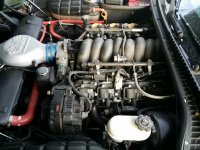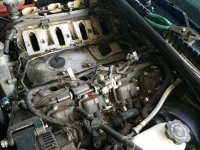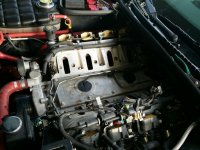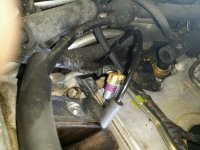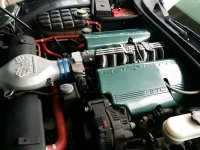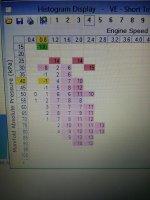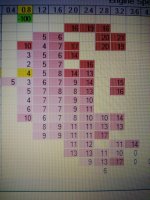-
Got the Contributing Memberships stuff finally worked out and made up a thread as a sort of "How-To" to help people figure out how to participate. So if you need help figuring it out, here's the thread you need to take a look at -> http://www.corvetteflorida.com/forums/showthread.php?t=3581 Thank you, everyone! Rich Z.
You are using an out of date browser. It may not display this or other websites correctly.
You should upgrade or use an alternative browser.
You should upgrade or use an alternative browser.
C5 intake manifold swap
- Thread starter mrr23
- Start date
I have to confess that I'm not all that familiar with HPTuners. With EFIlive, the AFR values for the VE data collection were multipliers that could be directly applied to the actual VE table to make alterations to the data to bring the table in line with what was wanted for each cell. But even after data collection and applying those values to the VE table, there was a lot of hand smoothing that had to be done. I don't think you could ever get it exactly perfect to where a data collection run would result in no changes being indicated. It took me a while to figure that out. :sillyme:
As for potential heat soak from the aluminum manifold, I'm not sure how that would manifest itself. The IAT sensor is in the air bridge, so the temperature of the incoming air is detected before it gets to the intake manifold. So my guess is that overheated air in the plenum would likely manifest itself by being detected when the knock sensors start yelping. :shrug01:
This has me wondering what overheated air in the plenum would do to the VE values. Would overheated air make the AFR appear leaner or richer? Hot air would be expanded air, so does that mean less air molecules or more? People say that the hotter the air the better for turbos to work efficiently because of increase VOLUME of air, but certainly that doesn't work the same when talking about feeding air into an engine cylinder. If there was such a difference would it be more pronounced in cylinder 7 than it would be in cylinder 1 because of the distance involved between the throttle body and the individual cylinders?
This kind of brings back memories of my working on the C5Z and having to ponder such things when I was having to figure out just exactly what the heck that VE table was in the first place.
As for potential heat soak from the aluminum manifold, I'm not sure how that would manifest itself. The IAT sensor is in the air bridge, so the temperature of the incoming air is detected before it gets to the intake manifold. So my guess is that overheated air in the plenum would likely manifest itself by being detected when the knock sensors start yelping. :shrug01:
This has me wondering what overheated air in the plenum would do to the VE values. Would overheated air make the AFR appear leaner or richer? Hot air would be expanded air, so does that mean less air molecules or more? People say that the hotter the air the better for turbos to work efficiently because of increase VOLUME of air, but certainly that doesn't work the same when talking about feeding air into an engine cylinder. If there was such a difference would it be more pronounced in cylinder 7 than it would be in cylinder 1 because of the distance involved between the throttle body and the individual cylinders?
This kind of brings back memories of my working on the C5Z and having to ponder such things when I was having to figure out just exactly what the heck that VE table was in the first place.
mrr23
The Alignment Guy
Hptuners and efilive are basically the same. Same theory that you log the stft and multiply % into the ve tables.
The iat temp to map determines if any timing should be added/removed.
Hotter air is less oxygen per square inch.
For turbos, the hotter the exhaust pipes, the faster the gases will move through them. This spinning the turbo faster. You do not want hot air, hence intercoolers. Hotter air is less oxygen and can raise cylinder temps and cause detonation.
All i am doing here is noticing not much difference between stock ls1 intake vs the bbk. Thus disproving the heat soak debate. The iat helpse to prove this because the bbk air intake is aluminum as well. I monitored my friends ls6 intake with stock air bridge and saw the same iat temps while he was driving.
The iat temp to map determines if any timing should be added/removed.
Hotter air is less oxygen per square inch.
For turbos, the hotter the exhaust pipes, the faster the gases will move through them. This spinning the turbo faster. You do not want hot air, hence intercoolers. Hotter air is less oxygen and can raise cylinder temps and cause detonation.
All i am doing here is noticing not much difference between stock ls1 intake vs the bbk. Thus disproving the heat soak debate. The iat helpse to prove this because the bbk air intake is aluminum as well. I monitored my friends ls6 intake with stock air bridge and saw the same iat temps while he was driving.
Actually with EFIlive I was monitoring AFR directly with the wideband and not using stft at all. Matter of fact, during most of the tuning process, I had stft disabled so they wouldn't get in the way of the REAL AFR I was trying to monitor. When you move around the oxygen sensors by installing headers you are already screwing up the trim calculations anyway. If you are doing MAF tuning and have relocated the MAF sensor, that just throws yet another wrinkle into the calculations. Which is why I decided to go with a speed density tune. Well that and the fact that the turbos made the MAF useless in boost AFR calculations anyway. But I do have the stfts enabled in normal driving range anyway, just to compensate for differences in gasoline and such. But even now, I'm not really sure how necessary stfts are for the complications they introduce. If you watch a graph of their signals, they are constantly overshooting and undershooting stoich. I did adjust the amount of the overshoot and undershoot, though, which seemed to make those transitions smaller and the graph smoother looking. Probably just another case of "inconsequential differences" though.
Do you have an infrared heat gun? I'd be curious to see if there is any substantial difference in externally determined temperatures of the aluminum intake manifold and the air bridge after a long period of running time with the hood closed. I've heard of people trying to trick the IAT by moving the sensor further away from the engine, but I guess you have to wonder whether this is really a good idea or not. The calculations in the PCM for how much timing to pull per degree of temperature has probably been worked out to protect the engine. Making the PCM think that the IATs are cooler than they really are might not be a real good idea. :shrug01:
At one time I thought about just replacing the IAT with a simple fixed resistor and be done with it when I was playing around with the air bridge plumbing. The IAT is supposed to just be a simple thermistor, and I couldn't see any situation where the actual incoming air would get so hot as to actually be dangerous with my driving habits. So in all honestly, even if an aluminum intake manifold would get substantially hotter than a plastic intake, would it really make all that much difference?
I've heard of people with the roots style superchargers complaining about heat soak, and I guess I'm curious to know how they knew it was causing a problem. :shrug01:
Do you have an infrared heat gun? I'd be curious to see if there is any substantial difference in externally determined temperatures of the aluminum intake manifold and the air bridge after a long period of running time with the hood closed. I've heard of people trying to trick the IAT by moving the sensor further away from the engine, but I guess you have to wonder whether this is really a good idea or not. The calculations in the PCM for how much timing to pull per degree of temperature has probably been worked out to protect the engine. Making the PCM think that the IATs are cooler than they really are might not be a real good idea. :shrug01:
At one time I thought about just replacing the IAT with a simple fixed resistor and be done with it when I was playing around with the air bridge plumbing. The IAT is supposed to just be a simple thermistor, and I couldn't see any situation where the actual incoming air would get so hot as to actually be dangerous with my driving habits. So in all honestly, even if an aluminum intake manifold would get substantially hotter than a plastic intake, would it really make all that much difference?
I've heard of people with the roots style superchargers complaining about heat soak, and I guess I'm curious to know how they knew it was causing a problem. :shrug01:

